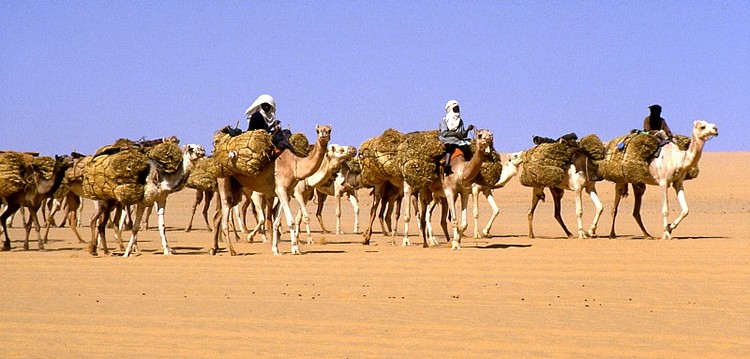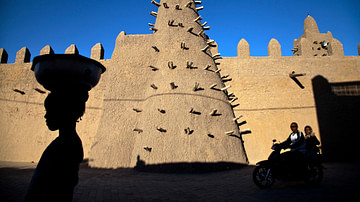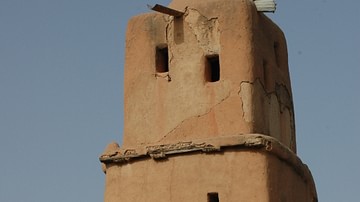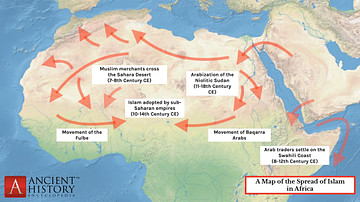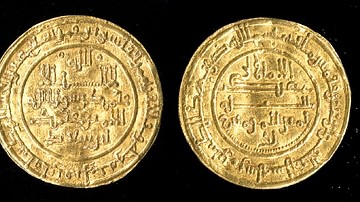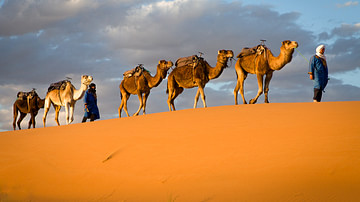
The Kingdom of Kanem (aka Kanim) was an ancient African state located in modern-day Chad, which flourished from the 9th to 14th century CE. With its heartland in the centre of the African continent on the eastern shores of Lake Chad, the kingdom was formed by a confederation of nomadic peoples and then ruled by the Saifawa dynasty. The city prospered thanks to its position as the hub of trade connections with central African peoples, the Nile Valley, and North African states on the other side of the Sahara Desert. The kingdom adopted the Islamic religion after long contact with Muslim clerics and traders from the 11th century CE onwards. In the 1390s CE Kanem's king was forced to flee the invading Bulala people and so set up a new state on the other side of Lake Chad, which would become the Bornu Empire, sometimes known as the Kanem-Bornu Empire, which lasted until the late 19th century CE.
Origins & Formation
The Kingdom of Kanem, located just to the east of Lake Chad in Central Africa, may derive its name from the Teda and Kanuri term for 'south' (anem) which refers to its position in relation to the better-known states to the north. Perhaps, too, the name reflects the oral tradition that the people of Kanem had once migrated from the Sahara Desert following that region's increased desiccation. The process which saw the formation of the kingdom of Kanem is here summarised by the historian P. Curtin:
Kanem passed through a process of state-building different from that of the western Sudan. The nucleus was a nomadic confederation of peoples speaking separate languages of the Teda-Daza group, probably formed in the 9th century. Nomadic confederations of this kind are common enough in history; the unusual thing is that this one held together. Sometime before the early twelfth century it had become sedentary itself, with Njimi as its permanent capital. (75)
The first mention of Kanem in texts dates to 872 CE and the work of the Arab historian and geographer al-Yaqubi (in his Kitab al-Buldan). Even if the state may have been formed a century earlier, it confirms the above political process as we are informed that the population is still at that time mostly composed of nomads who live in huts of reeds and who have not yet formed permanent settlements. We are also told that the kings of Kanem (here and in other Arab sources called Zaghawa) also ruled over other kings, likely the tribes they had conquered in the region north and east of Lake Chad. The Arab historian al-Muhallabi, writing in the 10th century CE, notes that the kingdom now has two towns and its wealth is evidenced by large herds of cattle, sheep, camels, and horses.
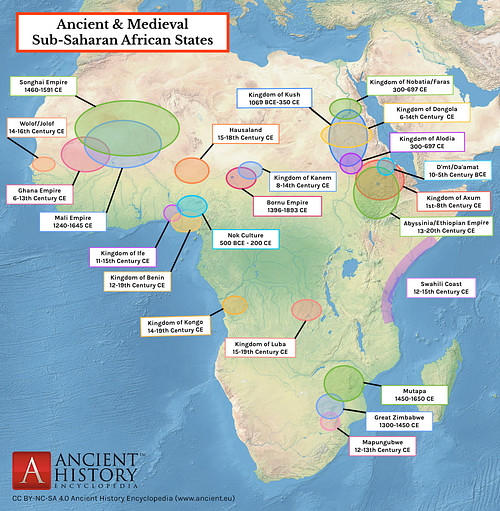
The Kings of Kanem
From c. 1075 CE Kanem was ruled by the Saifawa (aka Sefawa) dynasty over a population which became dominated by the Kanuri people. The king had the title of Mai. One of the greatest kings was Mai Dunama Dibbalemi (r. c. 1221-1259 CE) who expanded the kingdom further north and northeast into the desert, largely thanks to the use of cavalry. Military commanders were rewarded for their service by the award of governorship of conquered regions, and intermarriage between royal houses was a tried and tested strategy to cement new chieftains into the Kanem kingdom. Subjugated tribes were obliged to pay the Kanem kings tribute, typically in the form of slaves.
By the end of the 13th century CE, the kingdom was at its height and even controlled the vital Saharan oases of the Fezzan region, although it could not hold on to such a hot property for more than half a century. Dibbalemi was also one of the most vehement opponents of the old pagan religion, the Muslim king ordering the destruction of objects and symbols pertaining to it and imposing features of Islamic law. Nevertheless, the authority of the Kanem kings seems to have been absolute and not entirely in accord with the usual version of Islam, as here recorded by the Arab author Yaqut in his 13th-century CE 'Dictionary of Countries' (Kitab Mu'jam al-Buldan):
They exalt their king and worship him instead of God. They imagine that he does not eat any food. There are persons who have charge of this food secretly, and bring it to his house. It is not known where it is brought from. If it happens that one of his subjects meets the camels carrying provisions, he is killed instantly on the spot. He drinks his beverage in the presence of his select companions…Their religion is the worship of their kings, for they believe that they bring life and death, sickness and health.
(quoted in Fage, 681)
Adoption of Islam
It is not clear when the kingdom adopted Islam and under what circumstances except that is was probably not until the early 13th century CE that it was practised widely by the general populace as Arab sources covering before that time specifically state the kingdom was still pagan. The first Kanem ruler who is recorded as being a Muslim was, however, much earlier, one Hu (aka Hawwa, r. 1067-1071 CE) who may actually have been a queen. Thereafter, many Kanem rulers made pilgrimages to Islam's holy sites in North Africa and Arabia. In addition, one king founded a Muslim educational institution (madrasa) at Fustat in Egypt in 1324 CE.
The most likely explanation for the kings adopting Islam is that, as in other Sub-Saharan states, this gained them favour with Muslim traders and greater riches with which to impress their people and hold on to power. Alternatively, a new dynasty may have been bolstered in its claims of legitimacy by also adopting a new religion. The dates for the adoption by rulers and the change to the Saifawa dynasty do more or less match. Certainly, there were Muslim clerics who travelled as missionaries - the first visited Kanem as early as the 11th century CE - and so the trade explanation does not provide the full picture of the spread of this religion. Further, the missionaries were well received, at least according to Arab sources, and often given gifts for teaching the Koran such as camels, slaves, and gold and silver coins. Kanem was unusual in that a high number of the ordinary population eventually adopted the religion along with the ruling elite, something which was not the typical case elsewhere.
A Trade Hub
From c. 900 CE the kingdom was the end of a camel caravan route that crossed the Sahara Desert passing trade goods between Tripolitania (modern Libya) and Cairo in North Africa down to Central Africa. This trans-Saharan route was one of the best as it was well-served by the regular oases that dotted the Fezzan region. There was also a route to the east and the Nile Valley via the Kawar salt pans. Salt, copper (also used as a currency), tin (from Nigeria), cotton, hides, kola nuts, ivory, ostrich feathers, camels, and gold passed through the kingdom, as did slaves which were actively seized from neighbouring chiefdoms by the kings of Kanem, or given as tribute as mentioned above. The elite of Kanem spent their accumulated wealth on such imported luxuries as embroidered cloth, silk, jewellery, and iron weapons. Not only material goods but also ideas passed along these trade routes, chief amongst them, as we have seen, was the Islamic religion.
The Bornu Empire
The Bornu Empire was founded by an exiled king of Kanem, Uma b. Idris, who had been forced to flee following the takeover of that kingdom between 1390 and 1400 CE by the Bulala, a mysterious group who may have been a single tribe or clan group of pastoralists. A contributing factor to the defeat at the hands of the Bulala was the incessant civil wars that had blighted Kanem as the royal family got ever bigger and relations fought over the right to rule.
The ruling dynasty of Kanem, in effect, became the kings of Bornu, although how they imposed themselves on the indigenous So people who inhabited the western shores of Lake Chad is unclear. The So people did eventually assimilate the Kanuri language and culture, and the move was not without its advantages for the Kanem kings as the region west of Lake Chad was much richer in iron deposits. The Bornu Empire, sometimes referred to as the Kanem-Bornu Empire or Borno Empire, had its capital at Gazargamo and grew to control both sides of Lake Chad from the 16th century CE by eventually taking over the old Kanem territory. The empire would endure until the late 19th century CE when it was taken over by the French as they ambitiously sought to build a horizontal line of colonies across Africa.
